Ludwig scale is one of the most widely used scales for the classification of hair loss in women.
It’s not just for any type of hair loss – it’s used for identifying the stages of female pattern baldness or androgenetic alopecia.
Defining the different stages of the condition, it can actually help in its early diagnosis and treatment. On the other hand, professionals can use it to determine how severe the hair loss is in the first place.
Therefore, it is a very helpful tool. And it can be a good idea to learn what it exactly is and how the Ludwig scale for hair loss can be used to treat pattern baldness in women.
What Is The Ludwig Scale?
In 1977, Erich Ludwig published a paper in the British Journal of Dermatology, presenting a classification system for female pattern baldness.
Earlier classification systems had been developed for male pattern baldness. The first one came out in 1950, and from there, it continued to evolve until most practitioners settled on the Norwood-Hamilton scale (newer and better scales have been developed since).
However, these systems didn’t describe how hair loss progressed in women with androgenetic alopecia. While rarely it can follow the pattern of baldness in males, it’s usually quite different.
Ludwig studied 468 females for a few years and presented a new scale showing a different progression of female androgenetic alopecia.
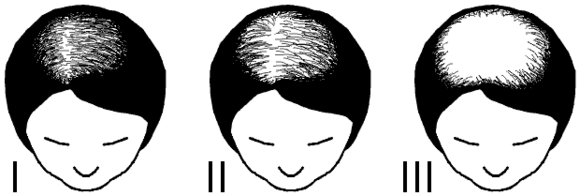
Starting at the crown, it spreads to the entire top part of the scalp. The hairline fringe and hair on the sides and back were unaffected.
This kind of hair loss doesn’t happen suddenly. The progression can take quite a few years. In the earlier stages, you might not even notice a difference.
However, of course, it becomes more pronounced with time. The hair follicles will also miniaturise, becoming thinner and shorter.
What Is The Ludwig Scale Used To Measure?
The Ludwig scale is used to measure the severity of androgenetic alopecia in women.
It can also be used for the early detection of this type of hair loss. And with that, it might be possible for you to get good results from your hair loss treatment.
Keep in mind that the more severe the hair loss is, the more difficult the treatment might be.
How To Use The Ludwig Scale?
Trained professionals can reference the stages in the Ludwig hair scale to determine the progression of pattern baldness in females.
You can also try doing the same by matching your hair loss with the pictures included in the Ludwig scale. However, that might be less accurate.
The best way to determine your hair loss on your own is to take pictures of your crown from different angles and in sufficiently bright light.
You can then put the picture right next to the different stages of the Ludwig hair loss scale to find out which one you’re closest to.
But you still shouldn’t jump to any conclusions based on that alone. Bear in mind that there are many different types of hair loss that can look the same.
For instance, central centrifugal cicatricial alopecia usually affects the crown and spreads centrifugally (outwards). It can also end up looking like female pattern baldness at different stages.
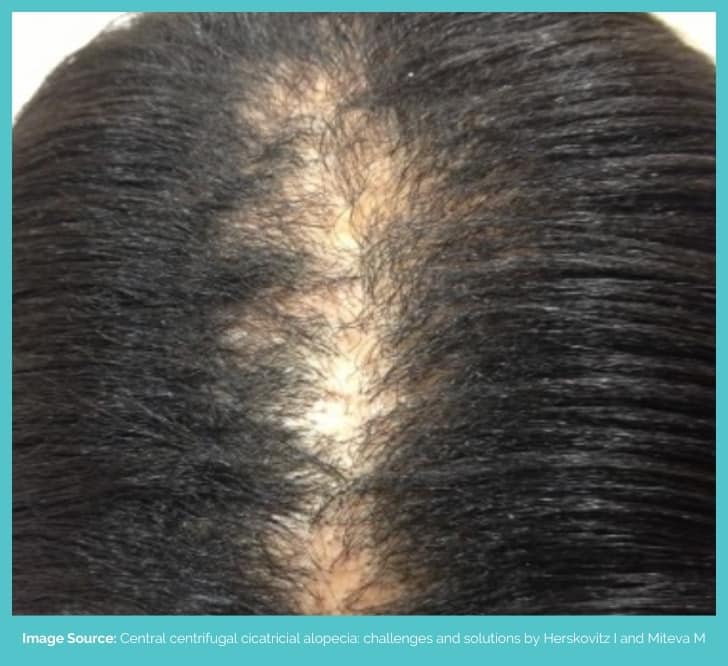
Central centrifugal alopecia can resemble female pattern hair loss since it also affects the crown.
Therefore, you should consult a board-certified and experienced medical professional for an accurate diagnosis.
What Are The Different Stages Of The Ludwig Scale?
There are three different stages of the Ludwig scale for female hair loss, which are as follows:
Stage 1
There’s a noticeable thinning of the hair in the crown region of the scalp. Moreover, there’s a slight widening of the parting line in the hair. The hair loss itself stops 1-3 cm behind the hairline at the front.
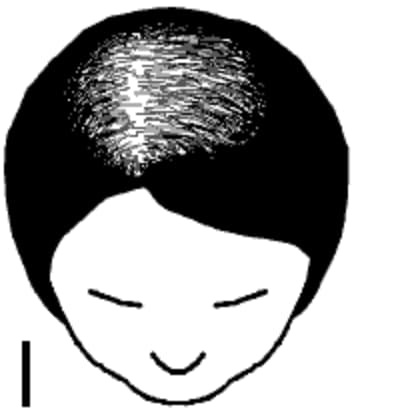
Stage 2
The progression of hair loss continues, and the hair in the crown area becomes more sparse. At this point, the scalp skin is clearly visible through the hair.

The part line will have also widened further, and you’ll see more miniaturised hairs (thin and short).
Stage 3
There’s a complete loss of hair in the crown and top part of the scalp. There’s a narrow fringe of hairline at the front.
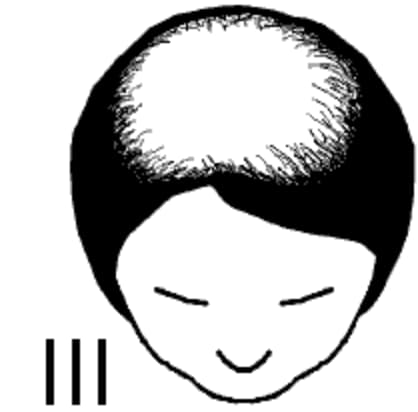
And there’s hair at the sides and back of the scalp as well. With the exception of the hairline, it can resemble the pattern of hair loss in men.
Ludwig Scale For Female Hair Loss
Describing the pattern of hair loss in women for the first time, the Ludwig alopecia scale is still widely known. However, it still has certain limitations.
In particular, it does not account for the patterns of hair loss in women in which the front hairline is also affected or the hair loss is diffuse.
The hair parting line is also at the side, instead of the centre, which hid a kind of pattern that was later described by Olsen as “Christmas tree” shaped.
The images also don’t show the progression of hair loss in more detail. This was especially improved on in the “Savin scale” (also developed for female pattern baldness).
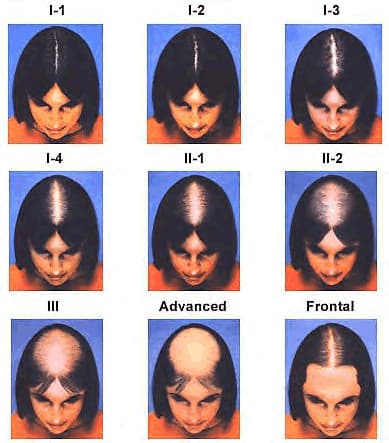
Still, the Ludwig scale provided the foundation for the first female hair loss density scale. Ludwig’s scale was used by many researchers who developed new scales for further improvement.
How To Treat The Ludwig Scale?
If you have Ludwig scale female pattern hair loss, there are different treatments that might be able to help you.
Your doctor might prescribe minoxidil. It’s a vasodilator, so it may with hair growth by sending more nutrients and oxygen to your scalp.
The anti-androgen spironolactone is also commonly prescribed (off-label) for the treatment of female pattern hair loss.
However, both these drugs can cause side effects, and their results are not permanent; you have to keep taking the medication to sustain hair growth.
There are other non-surgical treatment options you can consider, such as laser and platelet-rich plasma injections.
But if you’re looking for more permanent and dramatic results, you should consider getting an FUE hair transplant for your Ludwig scale alopecia. You can get this surgery as long as you have sufficient hair on the back and sides.
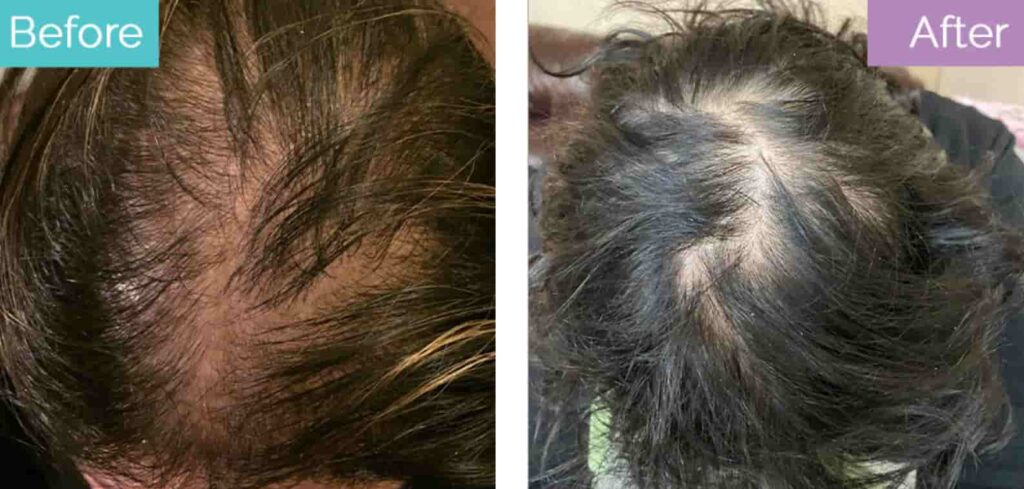
And if you’re looking to save costs, you can become a medical tourist and get a hair transplant in Istanbul. It’s quite affordable, and you’ll get high-quality surgery.
Conclusion
Ludwig scale was the first-ever tool to classify the pattern of hair loss in women. Even though it’s quite simple, it was and still is quite helpful.
For one, it can determine how severe your hair loss is. Secondly, it can even help in the early diagnosis of androgenetic alopecia. But in spite of its simplicity, it should not be used as the only diagnostic test for this type of hair loss.
Other types of hair loss can resemble pattern baldness in women. Also, this tool does miss out on many details of androgenetic alopecia in women.
So, if you’re experiencing abnormal hair loss, make sure to get in touch with a qualified and experienced medical professional. They’ll give you an accurate diagnosis and prepare an effective treatment plan accordingly.
Reviewed and Approved by Trichologist Yaprak Yazan


